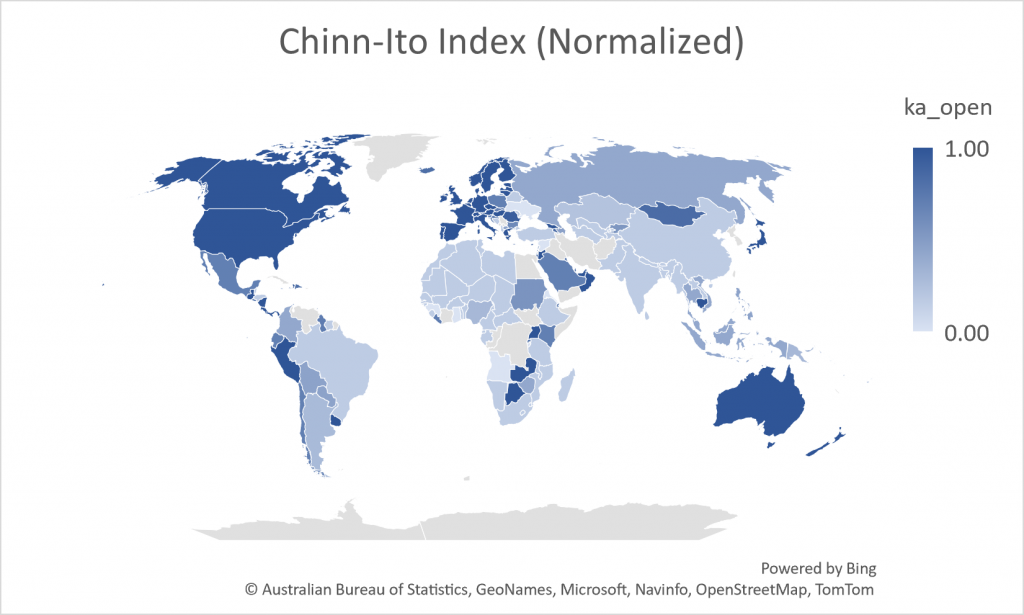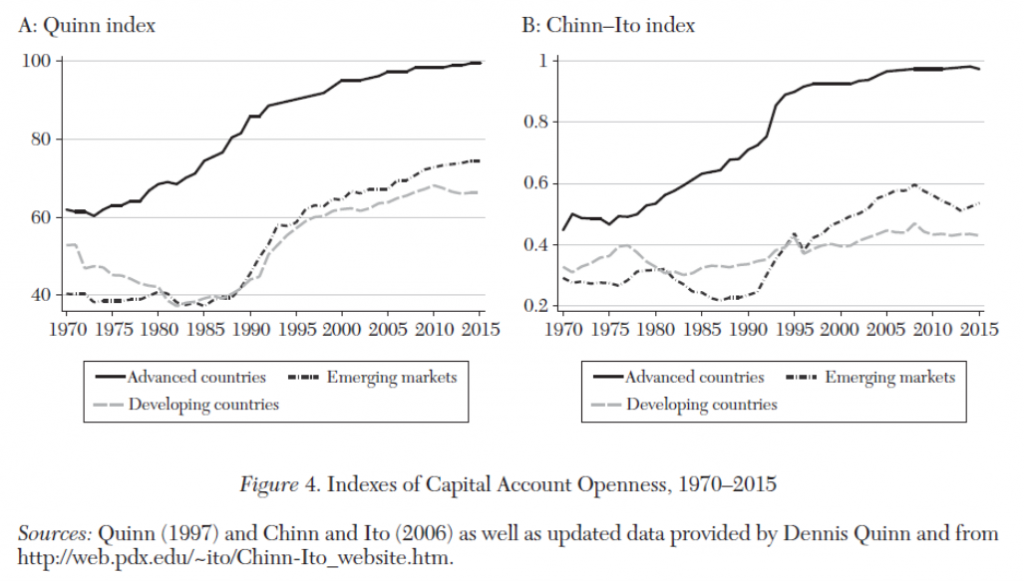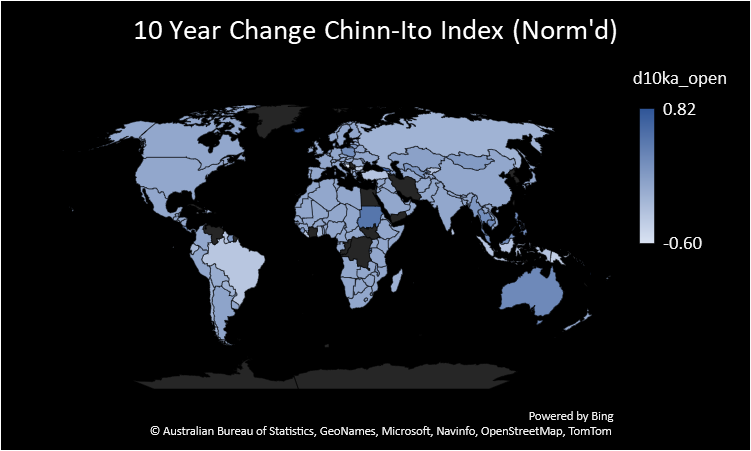We first constructed the index 20 years ago (Chinn and Ito, NBER WP No. 8967)! See the website for the data.
Here’s a map of financial openness in 2020 (normalized index, 1 to 0). The darker, the more open.
The description of the current dataset is Ito and Chinn (2022).
Hiro Ito and I constructed the index because there was few single, widely available and consistently updated measures of financial openness at the time, with the exception of Quinn’s (APSR, 1997) measure, which at the time was more limited in coverage. Individual dummy variables based on the IMF’s (old) de jure classification of controls (on exchange rates, export proceeds, capital account, current account) didn’t prove informative in one of my early empirical analyses of financial development (Chinn, 2004, ungated version here). The Chinn-Ito index, based on the aforementioned IMF de jure classifications, was converted into a single index using by taking the first principal component (essentially — the capital account component is smoothed), and was developed for a project to assess how financial openness correlates with financial development, published in JDE (2006) (with lots of help from friends, including Ashok Mody, Antu Panini Murshid).
Quinn, Schindler and Toyoda (IMF Econ Rev 2011) provide an early comparison of measures. More recent comparisons are in Graebner et al. (2021) and Erten et al. (2021). In the aggregate, the measures move together.
Source:Erten, Korinek, Ocampo (JEL, 2021).
However, on an individual country-year basis, the correlation of changes in the KAOPEN index and changes in other indices ranges from 0.01 to 0.29 (the latter significantly different from zero).
Ito and I do not claim there aren’t better indicators. For instance, the one created by Fernández, Klein, Rebucci, Schindler and Uribe (2016) is based on the IMF’s more detailed tabulation of de jure restrictions, both on inbound and outbound flows, and probably better captures the impact of controls. However, the coverage of this index is restricted to 1995 onward, limiting the span of data that can be analyzed statistically.
The map above shows a snapshot of financial openness. What does our index say about the evolution of financial openness over the past decade (2010 to 2020)? Here is a map of the change in our index.
The darker the color, the greater the increase in measured financial opennes..
Note that there has been substantial stability in the degree of financial openness; in the map above, most countries experience a 0 change in ka_open (e.g., China).



Knowing the relative openness of an economy, financial or otherwise, is interesting in itself. However, the claim made by liberal (in the old-fashioned sense) economics is that openness, exposure to market forces, is good for ya, like spinach. That claim is often questioned. Has the Chinn-Ito index (or the Quinn measure or any other quantified measure of openness) helped clear up this issue?
Doesn’t seem to help much with supply chain issues during a pandemic.
Also the USA may AT SOME TIME (ever tell a half-complex joke to a dumb person and stopwatch when they start laughing??) ask itself if handing over IP, technology, and superior manufacturing processes away FREE to China and then having China pull back beforehand promised market share like Lucy pulls back the football when Charlie Brown tries to kick it may not be in USA’s “best interest”.
Macroduck: Eichengreen & Lebland (2008).
Gracias.
Great question and great suggested reading from MC. Thank you.
https://english.news.cn/20220919/4d5f11c2476b45f4ba6f99587e6b9a1f/c.html
September 19, 2022
China’s FDI inflow up 16.4 pct in first eight months
BEIJING — Foreign direct investment (FDI) into the Chinese mainland, in actual use, expanded 16.4 percent year on year to 892.74 billion yuan in the first eight months of the year, the Ministry of Commerce said Monday.
In U.S. dollar terms, the inflow went up 20.2 percent year on year to 138.41 billion U.S. dollars.
The service industry saw FDI inflow jump by 8.7 percent year on year to 662.13 billion yuan, while that of high-tech industries surged by 33.6 percent from a year earlier, data from the ministry showed.
Specifically, FDI in high-tech manufacturing rose 43.1 percent from the same period a year ago, while that in the high-tech service sector surged 31 percent year on year….
[ China’s economy has been and will continue steadily opening, but opening in a necessarily protective manner for a developing economy. A remarkable 45 years of growth, the lifting of hundreds of millions from poverty and the increasing environmental soundness of China show how properly managed China’s opening has been. ]
Not remotely so remarkable compared to the record of Taiwan. PRC is not superior to Taiwan on any meaningful measure of the quality of human life, not material, not political, not spiritual. Taiwan has higher per capita income, greater equality of income, better health and life expectancy, higher education, and, of course, far more freedom and democracy. It does not have massive “surveillance and intimidation” as reported in the recent WaPo article that reported PRC ending reeducation camps in Xinjiang, and it certainly does not have those either. PRC has 1.4 million political prisoners; Taiwan barely has any.
The only things that PRC has that ROC does not are items related to large scale. So, Taiwan does not have a space program or certain large scale R&D activities or large scale lending to other nations. But in terms of per person things that affect quality of life, Taiwan is better on all of them than PRC. Period.
https://www.nytimes.com/2022/10/06/opinion/fed-inflation-interest-rates.html
October 6, 2022
Tracking the Coming Economic Storm
By Paul Krugman
Meteorologists tell us that global warming has created new problems for forecasters. Not only are hurricanes getting stronger, they’re also intensifying more rapidly than they used to, making it difficult to issue early warnings for communities in their path. Notably, officials in Florida’s Lee County waited for definitive evidence that they would be hit hard by Hurricane Ian before ordering evacuations — and by then it was too late for many people.
Is something similar happening with economic policy? Recently I wrote about the growing buzz from economists and businesspeople to the effect that the Federal Reserve, which has been trying to slow the economy to fight inflation, is braking too hard. Since then the buzz has intensified. And I’m increasingly convinced that, despite a disappointing inflation report and what still looks by some measures like a robust job market, the Fed is getting behind the curve.
We are, I’d now argue, just starting to see the effects of the interest rate hikes the Fed has been making since early this year. Never mind what inflation and jobs data are saying right now; there’s a lot of reduction in inflationary pressures — and a lot of drag on output and employment — already in the pipeline. The economy, as some business analysts like to say, may well be “rolling over.”
And the risks a hard-money policy poses to financial stability and the world economy in general are looming larger.
Part of the problem is that the Fed hasn’t done what it’s doing now — drastically tightening money to fight inflation — for a long time, indeed since the early 1980s….
what is financial stability….. to Joe, no longer can afford a six pack, who can only have one of: heat, food or driving to work.
too many are worried about portfolios
when the pain is not to portfolio
and Putin, opec+ and lockdowns in china…. inflation is not solely softened by tight financial conditions
what is good for the real economy may not be financiers’ stability
“what is financial stability….. to Joe, no longer can afford a six pack, who can only have one of: heat, food or driving to work.”
actually, right now most people have access to all three. at least in the united states. it is in europe where they do not, thanks to the brutality of the russian invasion of ukraine.
https://www.fao.org/worldfoodsituation/foodpricesindex/en/
FAO Food Price Index
The FAO Food Price Index (FFPI) is a measure of the monthly change in international prices of a basket of food commodities. It consists of the average of five commodity group price indices weighted by the average export shares of each of the groups over 2014-2016.
Monthly release dates for 2022: 6 January, 3 February, 4 March, 8 April, 6 May, 3 June, 8 July, 5 August, 2 September, 7 October, 4 November, 2 December.
FAO Food Price Index drops for the sixth consecutive month
The FAO Food Price Index (FFPI) averaged 136.3 points in September 2022, down 1.5 points (1.1 percent) from August, marking the sixth monthly decline in a row. The FFPI’s decline in September was driven by a sharp fall in the international prices of vegetable oils and moderate decreases in those of sugar, meat and dairy products, more than offsetting a rebound in the cereal price sub-index. Despite the new decline, the FFPI remained 7.2 points (5.5 percent) above its value in the corresponding month last year….
:The FAO Food Price Index (FFPI) averaged 136.3 points in September 2022, down 1.5 points (1.1 percent) from August, marking the sixth monthly decline in a row.”
FFPI had reached 159.7 earlier during the year. This is a most welcomed decline.
https://dnyuz.com/2022/10/06/russian-soldiers-left-for-dead-after-heavy-defeat-in-lyman-cauldron/
When Ukraine retook Lyman, 1500 Russian soldiers not only died but were abandoned by their leaders. It is no wonder the Russian soldiers have low morale. They realize Putin does not care about anyone of them.
The problem with being a ruthless sociopathic dictator is that you really don’t get this morale thing. Your world is one of gaining then applying power. Killing or intimidating those who do not follow your orders. When you cannot feel loyalty to others you don’t understand how to gain and keep it.
By anecdotes in the news, the exodus of potential draftees (if that’s what you call them) hasn’t abated. Gee, I wonder why.
Less than 100,000 people fled the US during the Vietnam draft (according to what I read) over several years. Last I read, 700,000 have left Russia in a matter of weeks, not counting all those who left before this “partial” mobilization, in a country smaller than 1960’s America.
https://www.bls.gov/news.release/empsit.nr0.htm
Total nonfarm payroll employment increased by 263,000 in September, and the unemployment rate edged down to 3.5 percent, the U.S. Bureau of Labor Statistics reported today.
The fall in the unemployment rate was in part due to a fall in the labor force participation. The household survey did report an increase in employment in excess of 200 thousand so this is still a strong jobs report. I guess the RECESSION cheerleaders will be upset.
https://news.cgtn.com/news/2022-10-06/China-makes-breakthrough-that-will-contribute-to-precise-navigation-1dU1IJWfjzO/index.html
October 6, 2022
China makes breakthrough that will contribute to precise navigation, quantum networks
Chinese scientists have made a major breakthrough that will contribute to various fields, such as precise navigation, redefining the fundamental unit of “second” and long-range quantum networks, according to a new study * published in the top journal Nature on Wednesday.
The study was jointly conducted by renowned Chinese quantum physicist Pan Jianwei’s team from the University of Science and Technology of China, and researchers from the Xinjiang Astronomical Observatory under the Chinese Academy of Sciences (CAS) and the Shanghai Institute of Technical Physics under the CAS.
They achieved high-precision free-space dissemination of time and frequency over 113 km for the first time in the world, a crucial step for establishing a global-scale optical clock network in the future, according to the study.
“It has been expected that an optical clock network connected by dissemination technology will open many exciting applications, including the next-generation definition of the unit of ‘second,’ testing general relativity, probing the changes of physical constants, searching for gravitational waves and dark matter, and long-range quantum networks,” they wrote.
“To establish a global-scale optical clock network, it is essential to disseminate time and frequency with a stability of 10−19 over a long-distance free-space link,” they added.
However, previous attempts at free-space dissemination of time and frequency at high precision did not extend beyond dozens of kilometers, according to the study.
“Here, we take a crucial step toward future satellite-based time-frequency disseminations,” the authors wrote.
* https://www.nature.com/articles/s41586-022-05228-5
https://fred.stlouisfed.org/graph/?g=rbMS
January 4, 2020
United States Employment-Population Ratio, * 2020-2022
* Employment age 25-54
https://fred.stlouisfed.org/graph/?g=IBTh
January 4, 2020
Average Hourly Earnings of All Private and Production & Nonsupervisory Workers, * 2020-2022
* Production and nonsupervisory workers accounting for approximately four-fifths of the total employment on private nonfarm payrolls
(Percent change)
I just heard some economic talking head say the drop in the labor force participation rate from 62.4% to 62.3% was not big deal as 62+% was a really high number. But is it?
https://fred.stlouisfed.org/series/CIVPART/
After RonJon’s misspeaking about too many jobs which prompted a lot of insulting noise from Econned, I tried to engage Econned in some actual labor economics. Of course Econned could not be bothered which is cool as he sucks at labor economics anyway.
I have long been hoping we would get labor force participation back to 63% so 62.4% does not strike me as high. Now I get that the lingering effects of COVID19 are still with us and we need higher real wages to induce people to choose to get back to work. We were making some progress until the beginning of the year but alas the labor force participation rate has been stuck for months.
Of course RonJon does not have a clue how to address this – and clearly Econned does not either.
It seems one hot Ukrainian lady has figured out how to get horny Russian soldiers to give away their positions!
https://metro.co.uk/2022/10/07/ukrainian-teen-used-dating-site-to-catfish-russian-soldiers-in-kherson-17523030/
A Ukrainian teenager forced out of her home by Russian invaders has turned to technology to get her revenge. She is using a dating app to flirt with enemy soldiers and get them to send her pictures, videos and voicemails. That is leading them to unwittingly give away sensitive information that she is passing on to investigators to help track Russians down. She even got one soldier to reveal the location of a boarding school being used as a base, while another shared pictures of a mansion being used to house a senior officer.
I’m not taking away from your point, which is a good one and a “fun” one, but this is old news. And it’s more than just one Ukraine girl who is using her “feminine wiles” in a useful, constructive, intelligent, and really kinda admirable….. way. One only wonders how many months it will take “the typical Russian soldier” to catch on??? Apparently multiple months.
I’m curious as to why Russia outranks China. I would think that a crummy, corrupt petro-state run by a deranged war mongering punk would be less financially open than a diverse economy like China—and South Korea. Granted, if this assessment covers 20 years, then the events of the past year might not be fully reflected.
The real answer is probably to be found in the link Menzie gave above.
https://web.pdx.edu/~ito/Readme_kaopen2020.pdf
My “back of the envelope” “scribbles in a restaurant napkin” guess?? As backwards as Russia is on many things, they don’t have China’s absolute obsession over the life guiding philosophy “China great, foreigners evil animals”, which permeates both the general culture and the Beijing government.
It only measures financial openness. If you travel over to New Jersey, you will find a lot of evil mob bosses who have very open financial positions. One of them become the 45th President of the US.
I don’t know too much about the subject, but what I hear from young China experts (many themselves Chinese!) is that the process of liberalization of the Chinese financial sector has been slow, or at least has happened in fits and starts. Lots of room for government intervention and corruption in finance and also in things like bankruptcy courts. Both have seen big reforms but (my reading, from recollection) they tend to clean up local corruption but leave the national-level corruption untouched.
And then there’s the changes made in the last few years under Xi that you mention.
Bottom line: I once told a room full of said young China experts an anecdote about some smarty-pants describing China to me as a “neoliberal” country, and they all laughed hard.
I was just imagining in my mind, how hilarious mainland Chinese would take America blaming our gun culture on China’s “invention” of gunpowder. Yet they feel no need to view themselves as fully adult on the opium problem they had. Let’s take about 5 seconds to think about that and the natural conclusion. Yeah—western influence over…… ADULT mainland Chinese. Right?? Make up our confession and westerners ‘ll sign it, and mainland Chinese culture can go on being perfect. Cool way to look at life for them don’t you think?? As an adult and sophisticated culture/peoples I mean.
https://www.nytimes.com/2022/10/07/business/binance-hack.html
October 7, 2022
Binance Blockchain Hit by $570 Million Hack, Exposing Crypto Vulnerabilities
The world’s biggest cryptocurrency exchange confirmed that assets were stolen from the Binance Smart Chain network, the latest in a series of attacks on so-called cross-chain bridges.
By Ephrat Livni
https://www.nytimes.com/2022/09/28/technology/crypto-hacks-defi.html
September 28, 2022
The Crypto World Is on Edge After a String of Hacks
More than $2 billion in digital currency has been stolen in hacks this year, shaking faith in the experimental field of decentralized finance, known as DeFi.
By David Yaffe-Bellany